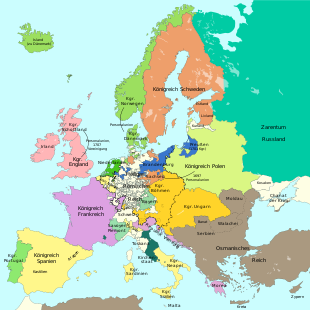Greifswald Alliance Agreement
The Greifswald Alliance Treaty was signed by the monarchs of the Electorate of Hanover , George I , and of the Russian Tsar , Peter I , on October 28, 1715 .
Its core provisions were directed against Sweden . Both sides come to an agreement with the aim of using military action to force Sweden to peace and to restore peace in the empire and in Northern Europe. In particular, Sweden should cede Ingermanland , Karelia , Estonia and the city of Reval to Russia , and the duchies of Bremen and Verden to Hanover . A formal unification of the four warring powers against Sweden ( Denmark , Prussia , Russia, Hanover) was envisaged.
Alliance treaties
Preobrazhenskoe (1699) • Dresden (1699) • Narva (1704) • Dresden (1709) • Thorn (1709) • Copenhagen (1709) • Hanover (1710) • Lutsk (1711) • Adrianople (1713) • Schwedt (1713) • Stettin (1715) • Berlin (1715) • Greifswald (1715)
Peace treaties
Traventhal (1700) • Warsaw (1705) • Altranstädt (1706) • Pruth (1711) • Frederiksborg (1720) • Stockholm (1719) • Stockholm (1720) • Nystad (1721) • Stockholm (1729)
Surrenders
Contract negotiations
One of the war aims of the German imperial estates involved in the Great Northern War was to oust Sweden from the soil of the Holy Roman Empire . Prussia aimed at the still Swedish part of Pomerania and Hanover at the Swedish duchies of Bremen and Verden since 1648 . The struggle (not only with Sweden, but also with Denmark, which belongs to the anti-Swedish alliance ) for the possession of these duchies was ultimately the decisive factor in Hanover’s involvement in the war.
As early as 1714, Hanoverian diplomats (including Andreas Gottlieb von Bernstorff ) held talks with Russia in support of the Hanoverian course, not only with the war opponent Sweden, but also with the allies, especially Denmark. For Russia, the desire for support from the English fleet was always in the background. The negotiations that led to the Greifswald alliance were conducted from 1715 between Boris Iwanowitsch Kurakin and war counselor JW Heusch (born around 1652), who had quarters in Greifswald. While there was agreement on the aims of the war, Articles 4 and 5 of the treaty were disputed, as Russia wanted to write the most far-reaching commitment possible to George I in his role as King of England. Since England was not at war with Sweden and entering the war would not have been enforceable domestically, George I insisted on an open formulation.
After the signing of the negotiating instrument, a diplomatic complication arose, which reveals the status of the codification and cementing of the principles of international and ceremonial law at that time. The Greifswald alliance is one of the few cases in which a monarch refused to ratify a signed and signed contract. Georg I invoked a violation of the principle of equality of negotiating partners and of the right to ceremonies . The Russian negotiator Kurakin signed and sealed both negotiating instruments in front of the Hanoverian Heusch .
New documents had to be issued, which were signed by a negotiator and then by the two monarchs. In addition, slight modifications were made to the controversial Articles 4 and 5. In Russia, the treaty was accompanied by high expectations, the close alliance hoped for support from the English fleet, although the contract partner had already refused to do so in the negotiations.
Content of the contract
The eight articles are written in Russian. The French translation has been pre-stapled. It follows chronologically:
[Ratification formula] Traditionally good relationship. Involvement of Hanover in the war against Sweden. Acquisition of the provinces as a goal. The aim of the alliance: restoring peace in the empire and in northern Europe.
- Article 1 Union of both parties. Close agreements.
- Article 2 Hanover takes part in war operations in order to fulfill the content of this Convention.
- Article 3 Russia also commits itself to the principles of Articles 1-2.
- Article 4 principles for peace with Sweden: Ingermanland , Karelia , Estonia (with Reval ) goes to Russia, Bremen-Verden to Hanover. This should also apply to peace with Sweden.
- Article 5 Hanover supports the interests of Russia.
- Article 6 Possible and existing alliances (Prussia, Denmark). Exclusion of a separate peace.
- Article 7 Negotiations with Prussia and Denmark as war allies.
- Article 8 Exchange of ratifications takes place in London.
[Ratification formula]
The original copy with the signature and the paper wafer seal of the exhibitor are passably preserved.
Web links
literature
- Felix Stoerk: The Greifswald alliance between Peter d. Size and Georg I. from October 28/17, 1715. in: Pommersche Jahrbücher 2 (1901), pp. 3-90. Mediger, Russia's way to Europe. Mediger, Mecklenburg, Russia and England-Hanover 1706–1721.
Remarks
- ^ The Hanoverian ratification took place on November 22nd / 3. December 1715. The instruments of ratification were exchanged on February 13, 1716 in Berlin. It is the second Russian ratification, the first of 13/24 November 1715 was not accepted by George I due to certain deficiencies.

